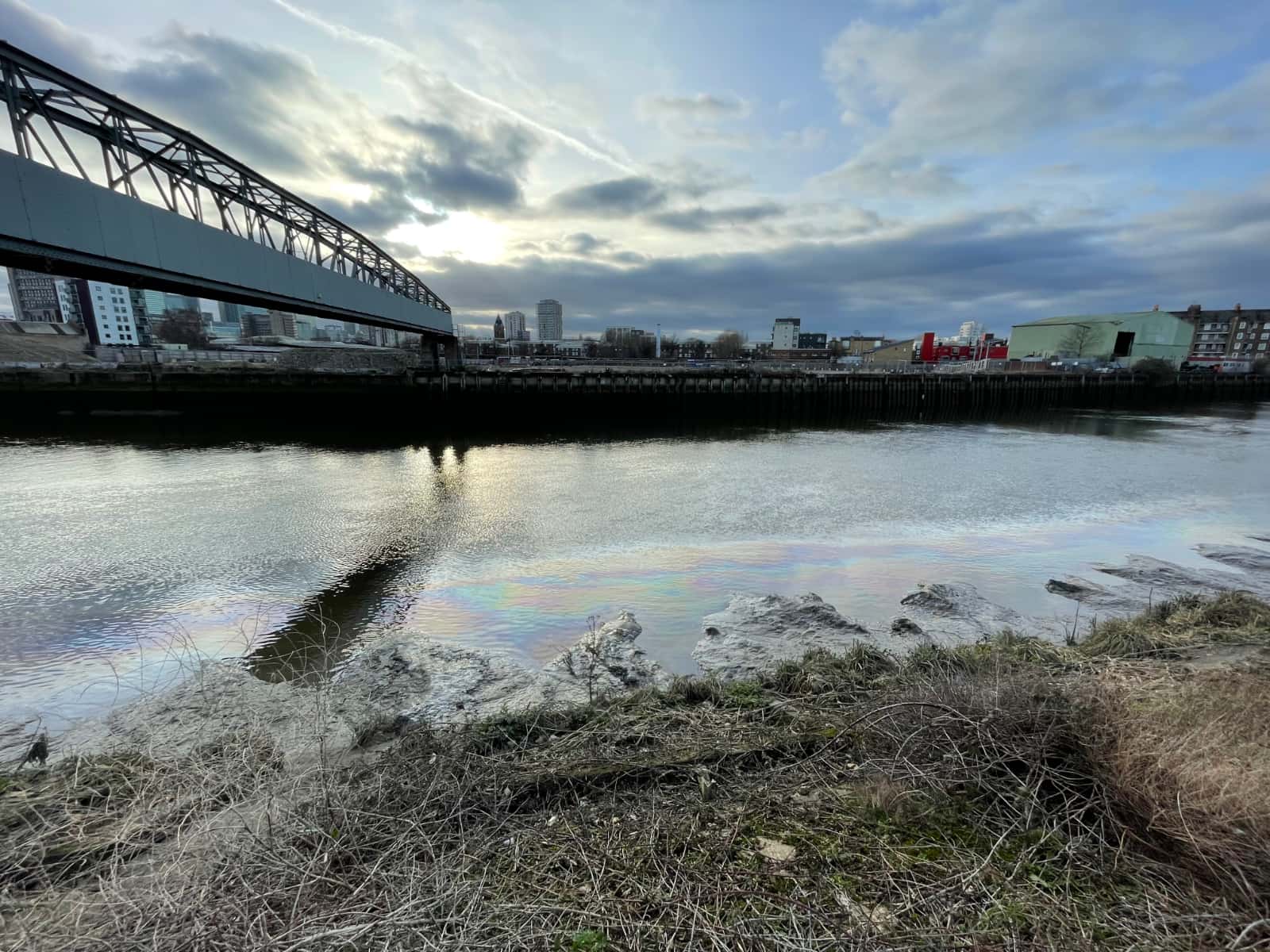Downloads
DOI:
https://doi.org/10.58981/bluepapers.2024.1.03Keywords:
post-industrial rivers, mobility, environmental degradation, regeneration, River LeaAbstract
This article explores the value of a mobilities lens in studying the nexus of water and heritage, specifically within the context of post-industrial rivers and the many regenerative and degenerative processes shaping them today. The River Lea (East London) showcases the complex, often conflicting, water-heritage dynamics that manifest across post-industrial riverscapes: efforts to (re)connect communities to rivers and their heritage become entangled with the (pollutive) imprints of industry. Using examples from the River Lea, the article highlights how a mobilities lens, currently underused in water-heritage studies, draws attention to (i) physical accessibility provisions surrounding rivers, (ii) (in)visible streams of fluid materials and (iii) the movements and moorings of more-than-human entities. These human, ecological and more-than-human mobilities can support but also sabotage efforts to regenerate post-industrial rivers, rendering a mobilities lens, with its ability to value and make visible multiple mobilities, indispensable to studying post-industrial rivers as key water-heritage sites.
How to Cite
Published
Issue
Section
License
Copyright (c) 2024 Maia Brons

This work is licensed under a Creative Commons Attribution 4.0 International License.
References
Boas, Ingrid, Hanne Wiegel, Carol Farbotko, Jeroen Warner and Mimi Sheller. 2022. “Climate Mobilities: Migration, Im/mobilities and Mobility Regimes in a Changing Climate.” Journal of Ethnic and Migration Studies 48, no. 14: 3365–79. https://doi.org/10.1080/1369183X.2022.2066264.
Bussi, Gianbattista, Paul G. Whitehead, Rosie Nelson, John Bryden, Cristopher R. Jackson, Andrew G. Hughes, Adrian P. Butler, et al. 2022. “Green Infrastructure and Climate Change Impacts on the Flow and Water Quality of Urban Catchments: Salmons Brook and Pymmes Brook in North-East London.” Hydrology Research 53, no. 4: 638–56. https://doi.org/10.2166/nh.2022.013.
Clifford, Jim. 2017. West Ham and the River Lea: A Social and Environmental History of London’s Industrialized Marshland, 1839–1914. Vancouver: UBC Press.
Corten, Jean-Paul. 2023. “Pondering the Past: Exploring the Synergy between Water Management and Heritage Management.” Blue Papers 2, no. 2: 56–67. https://doi.org/10.58981/bluepapers.2023.2.05.
Design for London. 2013. “Stitching the Fringe: Working around the Olympic Park.” Accessed January 5, 2024. https://live-qeop.pantheonsite.io/sites/default/files/attachments/s136682673StitchingtheFringeApr2013.pdf.
Dunkley, Ria Ann. 2018. “Monitoring Ecological Change in UK Woodlands and Rivers: An Exploration of the Relational Geographies of Citizen Science.” Transactions - Institute of British Geographers 44: 16–31. https://doi.org/10.1111/tran.12258.
Elgueta, Adriana, and Nicky Ford. 2024. “Hackney Wick: Homes and Businesses Ruined by Floodwater.” BBC News. Accessed February 18, 2024. https://www.bbc.com/news/uk-england-london-67892011.
Gasworks Dock Partnership. 2022. “Cody Dock Tidal Lea Ecology Report: 2021–22.” Accessed January 5, 2024. https://codydock.org.uk/wp-content/uploads/2022/06/Final-Cody-Dock-Ecology-Report-2021-spreads-AW.pdf.
Goh, Kian. 2021. Form and Flow: The Spatial Politics of Urban Resilience and Climate Justice. Cambridge, MA: MIT Press.
Hein, Carola. 2016. “Port Cities and Urban Waterfronts: How Localized Planning Ignores Water as a Connector.” WIREs Water 3: 419–38. https://doi.org/10.1002/wat2.1141.
Houart, Carlota. 2023. “Engaging with Water and Rivers from a Multispecies Justice Perspective.” Blue Papers 2, no. 1: 50–7. https://doi.org/10.58981/bluepapers.2023.1.05.
Kaaristo, Maarja, Dominic Medway, Jamie Burton, Steven Rhoden, and Helen L. Bruce. 2020. “Governing Mobilities on the UK Canal Network.” Mobilities 15, no. 6: 844–61. https://doi.org/10.1080/17450101.2020.1806507.
Kondolf, G. Mathias, and Pedro J. Pinto. 2017. “The Social Connectivity of Urban Rivers.” Geomorphology 227: 182–96. https://doi-org.libproxy.ucl.ac.uk/10.1016/j.geomorph.2016.09.028.
Laville, Sandra. 2020. “Revealed: Raw Sewage Poured into Olympic Park Wildlife Haven.” The Guardian (July 2). Accessed January 5, 2024. https://www.theguardian.com/environment/2020/jul/02/raw-sewage-olympic-park-wildlife-haven-wetlands-london-thames-water.
Mah, Alice. 2010. “Memory, Uncertainty and Industrial Ruination: Walker Riverside, Newcastle upon Tyne.” International Journal of Urban and Regional Research 34, no. 2: 243–51. https://doi.org/10.1111/j.1468-2427.2010.00898.x.
Patroncini, Deborah, Fabio Veronesi, and David Rawson. 2014. “Evaluation of River Water Quality: A Case Study of the Lea Navigation (NE London).” Water, Air & Soil Pollution 225: 1–16. http://dx.doi.org.libproxy.ucl.ac.uk/10.1007/s11270-014-2090-y.
Read, Simon. 2017. “Cinderella River.” Accessed February 12, 2024. https://repository.mdx.ac.uk/
Restemeyer, Britta, Margo van den Brink, and Johan Woltjer. 2019. “Decentralised Implementation of Flood Resilience Measures – A Blessing or a Curse? Lessons from the Thames Estuary 2100 Plan and the Royal Docks Regeneration.” Planning Practice & Research 34, no. 1: 62–83. https://doi.org/10.1080/02697459.2018.1546918.
Rhoden, Steven, and Maarja Kaaristo. 2020. “Liquidness: Conceptualising Water within Boating Tourism.” Annals of Tourism Research 81: 1–10. https://doi-org.libproxy.ucl.ac.uk/10.1016/j.annals.2019.102854.
Sodero, Stephanie. 2022. Under the Weather: Reimagining Mobility in the Climate Crisis. Kingston, Ontario: McGill-Queen’s University Press.
Tower Hamlets. n.d. “Lower Lea Bridges.” Accessed February 19, 2024. https://talk.towerhamlets.gov.uk/lower-lea-bridges.
Usher, Mark, Jonathan Huck, Gareth Clay, Emma Shuttleworth, and Janice Astbury. 2021. “Broaching the Brook: Daylighting, Community and the ‘Stickiness’ of Water.” EPE: Nature and Space 4, no. 4: 1487–514. https://doi-org.libproxy.ucl.ac.uk/10.1177/2514848620959589.
Verdini, Giulio, and Corinna Dean. 2022. “Climate Urbanism in the Post-Pandemic World: Mapping Vulnerabilities and Exploring Community Activism in East London.” In Design for Vulnerable Communities, edited by Emanuele Giorgi, Tiziano Cattaneo, Alfredo Mauricio Flores Herrera, Virginia del Socorro and Aceves Tarango, 245–62. Cham: Springer.
Wallace, Andrew, and Katy Wright. 2022. “The Post-Industrial English Canalscape: From Enclosure to Enlacement.” Cultural Geographies 29, no. 2: 185–202. https://doi-org.libproxy.ucl.ac.uk/10.1177/14744740211029275.




